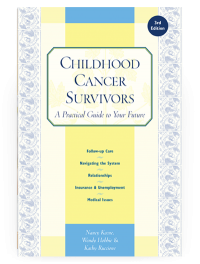Childhood Cancer Survivors
Pericardium
Pericarditis is an inflammation of the sac surrounding the heart. Acute pericarditis usually occurs during treatment or within the first year after treatment. Delayed acute pericarditis, a rare occurrence, usually resolves within a few months but may persist for years.
Constrictive pericarditis occurs when the sac surrounding the heart becomes tough and inelastic. This can result in an accumulation of fluid that can interfere with the heart’s ability to pump efficiently. Constrictive pericarditis can occur years after treatment.
Signs and symptoms
The signs and symptoms of delayed acute pericarditis include the following:
-
Fever
-
Shortness of breath
-
ST wave changes (elevation) on the EKG
The signs and symptoms of constrictive pericarditis include the following:
-
Chest pain
-
Wheezing
-
Shortness of breath
-
Decreased ability to exercise
I had nighttime coughing and I couldn’t sleep at night unless the head of the bed was raised. The coughing and wheezing was much less during the daytime. In my case, the pericarditis was misdiagnosed over a period of 2 years as adult onset asthma and anxiety. Even when I was in severe cardiac failure, I was sent home from the emergency room twice because no one expected to see a healthy-looking 47-year-old with congestive heart failure. I had emergency cardiac surgery to relieve an impending tamponade of the heart and again was misdiagnosed as having viral pericarditis. It was only when I went to Stanford that they correctly diagnosed the radiation damage to both the pericardium and heart muscle. I had a thoracotomy (opened the chest) and they removed a piece of the pericardium to allow the fluid to drain. Mind you, this was all 26 years post-treatment: 5100 rads (cGy) to mantle, 3100 rads to para-aortic chain followed by four sets of MOPP (a combination of chemotherapy drugs).
Screening and detection
Screening for pericarditis is the same as for other cardiac problems. However, if you develop any of the symptoms listed above, you should see your healthcare provider immediately to get an examination. Pericarditis can develop quickly and can be life threatening.
I had 4400 rads (cGy) of mantle radiation, 4400 to the mediastinum, and 4400 to the diaphragm and spleen area in 1968 to treat my Hodgkin’s disease. My pericardium became so fibrous that I almost died. They kept me in the hospital for a month to stabilize me, and then I had the pericardium removed during open chest surgery. It gave me immediate relief from the pain and heart arrhythmia, but I had problems healing since my skin is so fragile from the radiation.
Medical management
Radiation-induced pericarditis is treated with medications and sometimes with surgery.
This medical information can be a two-edged sword. Key for me has been with each new health challenge to find out what things I can do to help myself. For example, when I was in the hospital waiting for my pericardial stripping, I made it my job to eat at least 2,000 calories a day. I had lost a lot of weight and had no reserves. It turned my whole attitude around to have something important to do that would make a difference in the outcome, even though all the meds and surgery were being done by professionals. With information there is always the potential empowerment of each of us to make a difference in whatever we are faced with.
Recommended test schedules
Although recommendations evolve as more research is done, the current recommendations for heart evaluations after taking anthracyclines and/or having radiation to the heart are contained in the following table, which is based on the Children’s Oncology Group follow-up guidelines ( www.survivorshipguidelines.org ) . 4
Table 12-1. Recommended Cardiac Follow-Up
|
Age when treated with anthracyclines or radiation |
Radiation to the chest |
Total dose of doxorubicin, daunorubicin, epirubicin, and/or idarubin |
Schedule for echocardiogram |
|---|---|---|---|
|
Younger than 1 year old |
Yes |
None |
Every year |
|
Any |
Every year |
||
|
No |
< 200 mg/m 2 |
Every 2 years |
|
|
≥ 200 mg/m 2 |
Every year |
||
|
Ages 1 to 4 |
Yes |
None |
Every year |
|
Any |
Every year |
||
|
No |
< 100 mg/m 2 |
Every 5 years |
|
|
≥100 to < 300 mg/m 2 |
Every 2 years |
||
|
≥ 300 mg/m 2 |
Every year |
||
|
Ages 5 and older |
Yes |
None |
Every year |
|
< 300 mg/m 2 |
Every 2 years |
||
|
≥ 300 mg/m 2 |
Every year |
||
|
No |
< 200 mg/m 2 |
Every 5 years |
|
|
≥ 200 to < 300 mg/m 2 |
Every 2 years |
||
|
≥ 300 mg/m 2 |
Every year |
Table of Contents
All Guides- 1. Survivorship
- 2. Emotions
- 3. Relationships
- 4. Navigating the System
- 5. Staying Healthy
- 6. Diseases
- 7. Fatigue
- 8. Brain and Nerves
- 9. Hormone-Producing Glands
- 10. Eyes and Ears
- 11. Head and Neck
- 12. Heart and Blood Vessels
- 13. Lungs
- 14. Kidneys, Bladder, and Genitals
- 15. Liver, Stomach, and Intestines
- 16. Immune System
- 17. Muscles and Bones
- 18. Skin, Breasts, and Hair
- 19. Second Cancers
- 20. Homage
- Appendix A. Survivor Sketches
- Appendix B. Resources
- Appendix C. References
- Appendix D. About the Authors
- Appendix E. Childhood Cancer Guides (TM)

